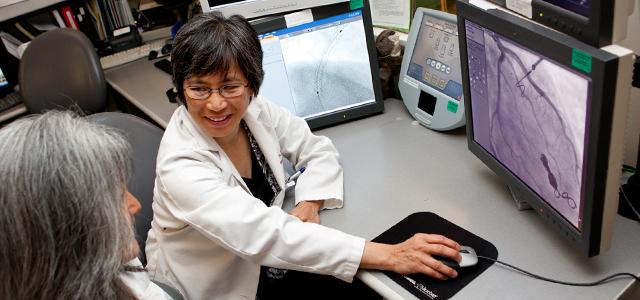
Laura Kee with a student in the UCSF Cardiac Catheterization Lab (photo by Elisabeth Fall)
What Volunteer Clinical Faculty Do: Laura Kee and Cardiovascular Nursing
Editor’s Note: Volunteer clinical faculty and preceptors offer students individual perspectives and hands-on experience in a variety of health care settings and specialties. The cumulative effect of what these volunteers impart plays a significant role in the care any health system delivers. This series aims to shed light on the unique roles these valuable mentors play.
This month we hear from Laura Kee, an associate clinical professor with UCSF School of Nursing and the clinical coordinator for interventional cardiology at UCSF Medical Center.
After working for a number of years in surgical and cardiovascular surgical ICUs, I was hungry to expand my knowledge and came to UCSF to study for my master’s degree. Afterwards, I worked in various research and clinical roles at UCSF, all involving the care of cardiovascular patients. After getting a taste of research through my master’s degree project and in my research position, I decided to pursue my PhD. Now I work in a clinical position in interventional cardiology that intertwines all that I have learned over the many years of my career.
While conducting my master’s research project, I met Dr. Nelson Schiller, a pioneer in echocardiography. Dr. Schiller served as my mentor through the project and then hired me as the first nurse in the UCSF Echocardiography Lab in 1987. I was exposed to various imaging modalities that helped to advance my understanding of clinical concepts in cardiovascular diseases. It was during this time that my eyes were opened to the value of seeing images in real time to help conceptualize cardiovascular disease, assessment and treatment.
My RN training occurred at a time when we used only text, illustrations and photographs to describe diseases, processes and conditions. Technology has changed all of that. I can bring theoretical concepts to life by using imaging modalities such as echocardiography and angiography. Illustrating concepts or information this way helps students make easier connections between what they learn in classes or books and clinical settings.
My current position as the clinical coordinator of interventional cardiology allows me to blend my interests in cardiac diagnostic testing and patient care. I focus on bridging the chasm between home and the medical center for patients undergoing invasive procedures in the cardiac catheterization laboratory. There are many issues that need to be addressed before and after procedures – patient education, insurance issues, clinical issues and social issues. We always think that when patients walk out the door, they are taken care of; but the reality is that when patients get home, all their questions rise to the surface. I work with patients, families, nurses and physicians to provide the best care we can for the patients.
In addition to my work, I teach first- and second-year master’s students at UCSF School of Nursing. I am fortunate to have been taught by many master clinicians and colleagues over the years, so I want to share what I have learned with students. Knowledge and techniques change so rapidly in the modern world that if I give them a compressed essence of what I have learned, I feel they are ready to take advantage of new developments.
I thoroughly enjoy working with these students, especially because most of them give their all and try to learn as much as possible. I love the challenge of breaking down difficult concepts so that students can understand them. I like to encourage students to think outside the box, beyond their comfort zone. It is so satisfying when I see the lightbulb go off.
As bedside nurses, we are mainly focused on the patient here and now. For advanced practice nursing, the challenge is seeing the broader perspective of the patient. I always tell my students that when you realize how much you don’t know, then your perspective has grown and you are ready to move on.



